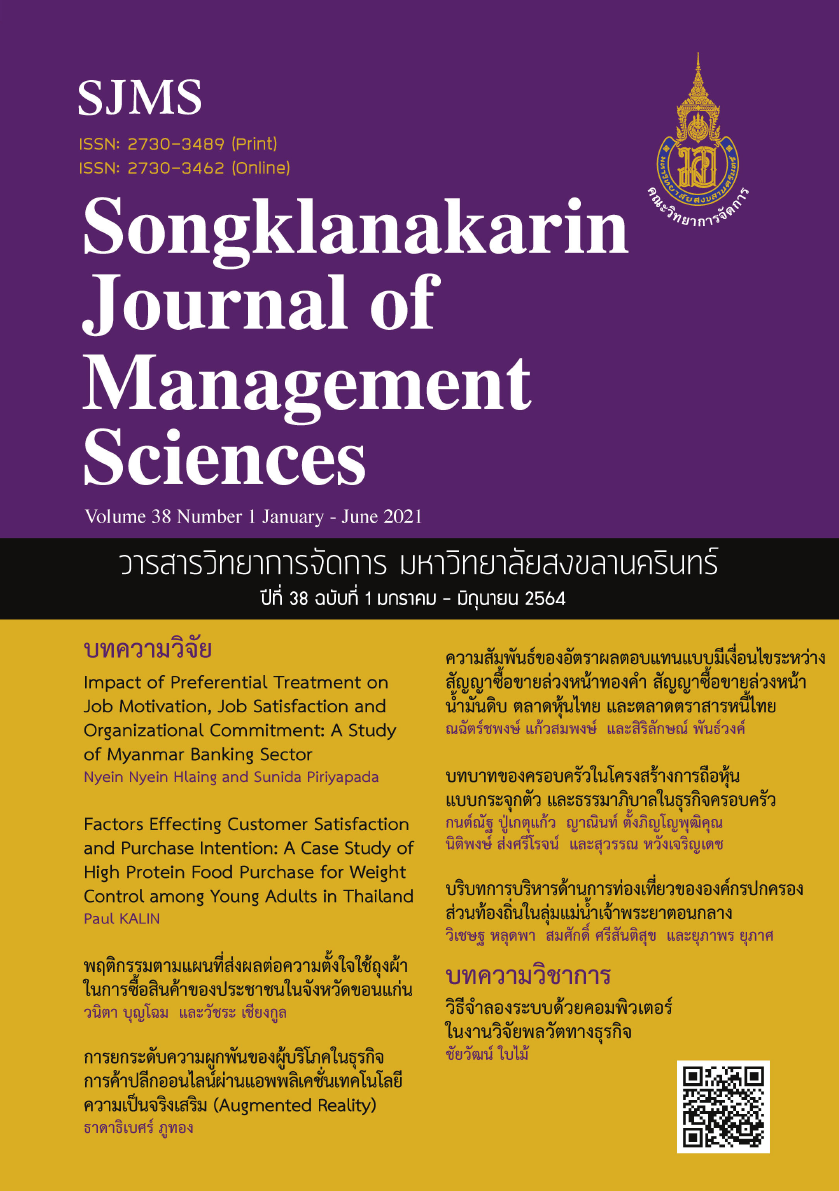Conditional Return Correlations between Gold Futures, Oil Futures, Thai Stock Market and Thai Bond Market
Main Article Content
Abstract
This study aims to examine the conditional returns correlations between commodity futures and traditional asset classes by using the DCC-GARCH model. The variables as a proxy for commodity futures include Gold futures and WTI futures. While the variables as a proxy for traditional assets, comprise equity securities and bonds. Moreover, this study also considers changing the exchange rate as an exogenous variable that is added to the variance equation of the GARCH because the appreciation or depreciation of the Thai baht, causing fluctuations in the prices of all four securities.
The results reveal that the correlation returns correlations between Thai stock market (SET) and WTI futures have a negative relationship over time. The highest value of this conditional correlation is -0.0692, and the lowest value is -0.4911. This can be indicated that WTI Futures have become better diversification tools in equity portfolio management. Besides, the conditional returns correlations between Gold Futures and SET declined in periods of financial market fluctuations. Thus, Gold Futures long position and owning few stocks in the portfolio as the benefits for investors, financial institutions, and fund managers who need to diversification of risk in equity portfolio management in periods of high volatility in the financial market.
Article Details

This work is licensed under a Creative Commons Attribution-NonCommercial-NoDerivatives 4.0 International License.
All published articles are SJMS’s copyright. The editorial board allows all published articles to be copied, excerpted, or disseminated with academic citation.
References
Billio, M., Caporin, M., & Gobbo, M. (2006). Flexible Dynamic Conditional Correlation multivariate GARCH models for asset allocation. Applied Financial Economics Letters, 2(2), 123-130.
Bodie, Z. (1983). Commodity futures as a hedge against inflation. Journal of Portfolio Management, 9(3), 12-17.
Bollerslev, T. (1986). Generalized autoregressive conditional heteroscedasticity. Journal of Econometrics, 31(3), 307-327.
Boyer. M. M., & Filion, D. (2007). Common and fundamental factors in stock returns of Canadian oil and gas companies. Energy Economics, 29(3), 428-453.
Broadstock, D. C., Cao, H., & Zhang, D. (2012). Oil shocks and their impact on energy related stocks in China. Energy Economics, 34(6), 1888-1895.
Chen, Q., & Lv, X. (2015). The extreme-value dependence between the crude oil price and Chinese stock markets. International Review of Economics and Finance, 39, 121-132.
Chodchuangnirun B., Yamaka W., & Khiewngamdee C. (2018). A regime switching for dynamic conditional correlation and GARCH: application to agricultural commodity price market risks. International Symposium on Integrated Uncertainty in Knowledge Modelling and Decision Making (pp. 289-301). Vietnam: Springer.
Chong, J., & Miffre, J. (2010). Conditional correlation and volatility in commodity futures and traditional asset markets. The Journal of Alternative Investments, 12(13), 61-75.
Daskalaki, C., & Skiadopoulos, G. (2011). Should investors include commodities in their portfolios after all? New evidence. Journal of Banking & Finance, 35(10), 2606-2626.
Engle, R. F. (2002). Dynamic conditional correlation: A simple class of multivariate generalized autoregressive conditional heteroscedasticity models. Journal of Business and Economic Statistics, 20(3), 339-350.
Foreign Trade Statistics of Thailand. (2018). Thai trade statistics, Retrieved November 1, 2019, from http://www2.ops3.moc.go.th/
Goodman, S. N. (1999). Toward evidence-based medical statistic. 2: The Bayes factor. Annals of Internal Medicine, 130(12), 1005-1021.
Jensen, G., Johnson, R., & Mercer, J. (2000). Efficient use of commodity futures in diversified portfolios. Journal of Futures Markets, 20(5), 489-506.
Kajornsin B. (2013). Analyzing the results of statistical. Retrieved November 1, 2019, from http://www.rlc.nrct.go.th/ewt_dl.php?nid=1159
Khashman, A., & Nwulu, N. I. (2011). Support Vector Machines Versus Back Propagation Algorithm for Oil Price Prediction. Proceeding of the 8th International Symposium on Neural Networks (pp. 530-538). Berlin: Springer.
Kumar, S., Pradhan, A. K., Tiwari A. K., & Kang, S. H. (2019). Correlations and volatility spillovers between oil, natural gas, and stock prices in India. Resources Policy, 62, 282-291.
Lamoureux, C. G., & Lastrapes, W. (1990). Heteroskedasticity in Stock Return Data: Volume versus GARCH Effects. Journal of Finance, 45(1), 221-29.
Le, T. H., & Chang, Y. (2011). Oil and gold: correlation or causation?, Working Papers 22, Development and Policies Research Center, Vietnam.
Lerkeitthamrong K., Khiewngamdee C., & Osathanunkul R. (2019). Impacts of Global Market Volatility and US Dollar on Agricultural Commodity Futures Prices: A Panel Cointegration Approach. International Conference of the Thailand Econometrics Society (pp. 412-422). Vietnam: Springer.
Pitisuksombat, Y., Wongtirawit, V., & Senjuntichai, A. (2011). Analysis of Gold Futures Investment by Forecasting Method. Research and Development Journal, 22(4), 62-68.
Puksamatanan, J. (2019). Oil Price, Retrieved November 1, 2019, from https://www.finnomena.com/dr-jitipol/3-worlds-oil/
Ratchadamarin, P. (2009). Factors Affecting the Movement of SET 50 Index Futures (Master’s Thesis). Ramkhamhaeng University. Bangkok.
Soytas, U., Sari, R., Hammoudeh, S., & Hacihasanoglu, E. (2009). World Oil Prices, Precious Metal Prices and Macroeconomy in Turkey. Energy Policy, 37(2), 5557-5566.
Sujit, K. S., & Kumar, R. B. (2011). Study on dynamic relationship among gold price, oil price, exchange rate and stock market returns. International journal of applied business and economic research, 9(2), 145-165.
The Stock Exchange of Thailand. (2015). Fundamental analysis. Retrieved November 1, 2019, from https://www.set.or.th/set/education/html.do?name=begin&showTitle=F
The Thai Bond Market Association. (2019). Composite Bond Index. Retrieved November 1, 2019, from http://www.thaibma.or.th/EN/Market/Index/CompositeIndex.asp
Tsai, I-C. (2012). The relationship between stock price index and exchange rate in Asian markets: Aquantile regression approach. Journal of International Financial Markets, Institutions and Money, 22(3), 609-621.

